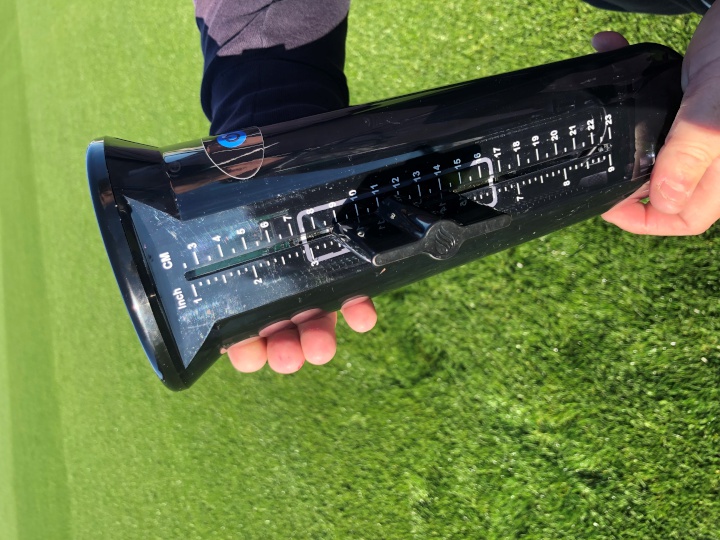Latest Tech Tracking Ground Breaking Biochar Use At Lansdowne Park
Gone are the days when a groundskeeper would put a finger to the wind or simply look out the window to check the weather.

Science meets sport . . . one of the new wireless soil moisture sensors recently installed at the rugby field
These days science meets sport at Blenheim’s No. 1 rugby field at Lansdowne Park, where the Council and its turf managers have turned to the latest technology to assist in managing the new sand-based surface.
Last week six wireless soil sensors were buried in the field to provide ‘live’ data, including soil moisture, temperature and salinity readings, via an app on a smartphone.
Will Bowden from New Zealand Turf Management Solutions (NZTMS), a turf consultant for the Council, said Lansdowne No. 1 was the first stadium field in New Zealand where biochar has been used in a sub-section of its soil composition.
Biochar is burnt charcoal produced from plant matter and is often used as a means of removing carbon dioxide from the atmosphere
“It’s also all about moisture and nutrient retention. It is good for the environment but also helps keep the irrigation and fertiliser used in the ground,” Mr Bowden said.
“We have never done this before. The sensors will give us hard and fast data that we are saving ‘x’ amount of water from irrigation and wastage from having biochar in the sand. We know the theory but it will be great to have field data to support this,” he said.
“This project offers a perfect opportunity to trial the units and provide us with some science,” he said. The sensors will be used to provide quarterly updates to the Council.
San Diego-based company GroundWorx offered the Council a free trial of the technology for up to 90 days to demonstrate its potential. If successful, the Council will own the system and the data it produces.
“Get up in the morning, view a dashboard on your phone and plan your day,” said Wellingtonian Lee Marshall, GroundWorx’s Oceania/Asia Master Agent and a co-founder of the company. “The sensors will collect the data to make those decisions. They are a wireless ‘cell phone in the ground’,” he said.
Each sensor contains two SIM cards - one Vodafone and one roaming - sending information up to the cloud every 10 minutes. The units have a battery life of up to seven years and a unique serial number to send updates directly to each unit anywhere in the world.
The installation of the sensors is a South Island first but the technology is already in use at Eden Park in Auckland and Sky Stadium in Wellington, plus a number of prestigious golf courses around the country.
Council Parks and Open Spaces Officer Robert Hutchinson said the new sand surface at Lansdowne required careful management for moisture levels. “This sensor technology is going to provide us with a good picture of how the systems are working with the water and biochar/sand combination,” he said.
It was hoped the No. 1 field would be in use by now but the recent storm delayed this. “We still need to get the new fold down goal posts in the ground and we have been waiting on the right weather conditions to get the concrete block foundations in for these,” Mr Hutchinson said.
The $700k renovations to the field are part of major redevelopments underway at the park, including a new multi-code sportshub building.


 Gordon Campbell: On What’s Wrong With The Treaty Principles Bill
Gordon Campbell: On What’s Wrong With The Treaty Principles Bill Department Of Internal Affairs: Samoan Citizenship Bill Passes Into Law
Department Of Internal Affairs: Samoan Citizenship Bill Passes Into Law NZ National Party: National Acknowledges The Passing Of Hon Nikki Kaye
NZ National Party: National Acknowledges The Passing Of Hon Nikki Kaye Mana Mokopuna: Children And Young People Share Vital Insights On Healing From Family Violence And Sexual Violence In New Report
Mana Mokopuna: Children And Young People Share Vital Insights On Healing From Family Violence And Sexual Violence In New Report NZ Government: PM Marks One Year In Government
NZ Government: PM Marks One Year In Government Helen Clark Foundation: Helen Clark Foundation Calls For Political Action To Reduce The Prevalence Of Junk Food And Improve Health Outcomes
Helen Clark Foundation: Helen Clark Foundation Calls For Political Action To Reduce The Prevalence Of Junk Food And Improve Health Outcomes Justice Committee: Further Decisions About Submissions Process For The Principles Of The Treaty Of Waitangi Bill
Justice Committee: Further Decisions About Submissions Process For The Principles Of The Treaty Of Waitangi Bill


